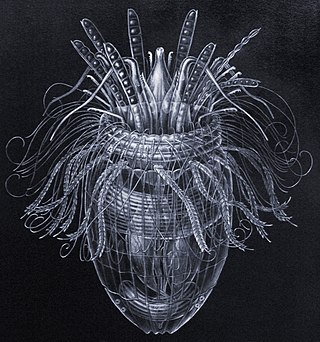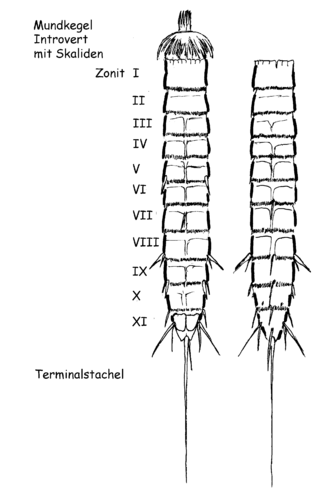
Loricifera is a phylum of very small to microscopic marine cycloneuralian sediment-dwelling animals with 43 described species. and approximately 100 more that have been collected and not yet described. Their sizes range from 100 μm to ca. 1 mm.

The Opiliones are an order of arachnids colloquially known as harvestmen, harvesters, harvest spiders, or daddy longlegs. As of April 2017, over 6,650 species of harvestmen have been discovered worldwide, although the total number of extant species may exceed 10,000. The order Opiliones includes five suborders: Cyphophthalmi, Eupnoi, Dyspnoi, Laniatores, and Tetrophthalmi, which were named in 2014.

Kinorhyncha is a phylum of small marine invertebrates that are widespread in mud or sand at all depths as part of the meiobenthos. They are also called mud dragons. Modern species are 1 mm (0.039 in) or less, but Cambrian forms could reach 4 cm (1.6 in).

The masked booby, also called the masked gannet or the blue-faced booby, is a large seabird of the booby and gannet family, Sulidae. First described by the French naturalist René-Primevère Lesson in 1831, the masked booby is one of six species of booby in the genus Sula. It has a typical sulid body shape, with a long pointed yellowish bill, long neck, aerodynamic body, long slender wings and pointed tail. The adult is bright white with black wings, a black tail and a dark face mask; at 75–85 cm (30–33 in) long, it is the largest species of booby. The sexes have similar plumage. This species ranges across tropical oceans, except in the eastern Atlantic and eastern Pacific. In the latter, it is replaced by the Nazca booby, which was formerly regarded as a subspecies of masked booby.

The red-capped robin is a small passerine bird native to Australia. Found in drier regions across much of the continent, it inhabits scrub and open woodland. Like many brightly coloured robins of the family Petroicidae, it is sexually dimorphic. Measuring 10.5–12.5 cm (4.1–4.9 in) in length, the robin has a small, thin, black bill, and dark brown eyes and legs. The male has a distinctive red cap and red breast, black upperparts, and a black tail with white tips. The underparts and shoulders are white. The female is an undistinguished grey-brown. This species uses a variety of songs, and males generally sing to advertise territories and attract females. Birds are encountered in pairs or small groups, but the social behaviour has been little studied.

Puccinellia is a genus of plants in the grass family, known as alkali grass or salt grass.

Cyclorhagida is a class of kinorhynchs, which are small marine invertebrates.
Antygomonas is a genus of cyclorhagids. It is the only genus in the family Antygomonidae Adrianov & Malakhov, 1994. Species of Antygomonas are commonly referred to as "mud dragons."
Rugiloricus is a genus of marine organisms of the phylum Loricifera and the family Pliciloricidae, described by Higgins & Kristensen in 1986.
Robert Price Higgins was an American systematic invertebrate zoologist and ecologist, specializing in the unusual taxa of kinorhynchs and tardigrades.
Urnaloricus is a genus of loricifera; it is distinct enough to belong to its own family, Urnaloricidae. Loricifera are phylum that are animals that live in marine area only, and very small in size. The Urnaloricus was found Southwest in the Faroe Islands, North Atlantic. It was the thirty-eighth loriciferan species found. One part of the life cycle is the Higgins larva and it is introverted with eight two-segmented clavoscalids.
Cephalorhyncha is a genus of kinorhynchs in the family Echinoderidae.
Cateriidae is a family of kinorhynchs placed either in the class Cyclorhagida or Allomalorhagida. It consists of a single genus, Cateria Gerlach, 1956.

Echinoderes is a genus of mud dragons first described in 1863. It is the largest genus within class Kinorhyncha. It is a highly diverse genus, with member species that inhabit "most marine benthic substrates, on latitudes ranging from the Arctic to the tropics, and from the intertidal zone down to the deep sea." Species on the east coasts of North and South America have been extensively studied by Robert P. Higgins. Species in east Asia have been extensively studied by A. V. Adrianov.

Zelinkaderidae is a family of worms belonging to the class Cyclorhagida.

Pycnophyes is a genus of worms belonging to the family Pycnophyidae.
Cristaphyes is a genus of worms belonging to the family Pycnophyidae.
Paracentrophyes is a genus of worms belonging to the family Neocentrophyidae.
Setaphyes is a genus of kinorhynchs within the family Pycnophyidae. There are currently 8 species assigned to the genus, with the most recent one being Setaphyes algarvensis in 2022.
Fujuriphyes is a genus of kinorhynchs within the family Pycnophyidae, with 9 species currently assigned to the genus.








